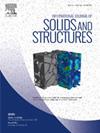Circumferential wave propagation in nonlinear dielectric bilayer tubes under inhomogeneous biasing fields
IF 3.4
3区 工程技术
Q1 MECHANICS
International Journal of Solids and Structures
Pub Date : 2025-01-28
DOI:10.1016/j.ijsolstr.2025.113247
引用次数: 0
Abstract
Dielectric elastomer structures with large deformation and electromechanical coupling are susceptible to biasing fields and show potentials in tunable elastic wave devices. This work focuses on circumferential waves in the incompressible isotropic dielectric bilayer tube subjected to an axial pre–stretch and radial voltage. Based on the nonlinear electroelasticity theory, the deformation of the structure characterized by the Gent ideal dielectric model is elaborated. The strain–stiffening enables the bilayer tube to resist large deformation and enhances the tunability under inhomogeneous biasing fields. In order to analyze the dynamic behaviors of circumferential shear horizontal (CSH) and Lamb–like (CLT) waves, the Legendre polynomial expansion method (LPEM) is combined with the linearized incremental equations to derive the dispersion relation. It overcomes the difficulties of conventional matrix methods in dealing with radial dependent electroelastic moduli and shows good convergence. Numerical results demonstrate that the pre–stretch, voltage and strain–stiffening can change the geometry and electroelastic moduli of the dielectric tube, which exhibit the potential to tune the propagation behaviors of circumferential waves. In addition, dispersion properties of circumferential waves are sensitive to the voltage change, which indicates that the dielectric bilayer tubular systems can act as voltage–controlled elastic wave actuators and sensors.
非均匀偏置场下非线性介质双层管的周向波传播
具有大变形和机电耦合的介电弹性体结构易受偏置场的影响,在可调谐弹性波器件中表现出潜力。本文研究了不可压缩各向同性介质双层管在轴向预拉伸和径向电压作用下的周向波。基于非线性电弹性理论,阐述了以根特理想介质模型为特征的结构的变形。应变强化使双层管能够抵抗大变形,提高了在非均匀偏置场下的可调性。为了分析周向剪切水平波(CSH)和Lamb-like波(CLT)的动力特性,将Legendre多项式展开法(LPEM)与线性化增量方程相结合,导出了色散关系。该方法克服了传统矩阵法处理径向相关电弹性模量的困难,具有较好的收敛性。结果表明,预拉伸、电压加筋和应变加筋可以改变介质管的几何形状和电弹性模量,从而具有调节周波传播特性的潜力。此外,周波的色散特性对电压变化很敏感,这表明介质双层管状系统可以作为电压控制的弹性波致动器和传感器。
本文章由计算机程序翻译,如有差异,请以英文原文为准。
求助全文
约1分钟内获得全文
求助全文
来源期刊
CiteScore
6.70
自引率
8.30%
发文量
405
审稿时长
70 days
期刊介绍:
The International Journal of Solids and Structures has as its objective the publication and dissemination of original research in Mechanics of Solids and Structures as a field of Applied Science and Engineering. It fosters thus the exchange of ideas among workers in different parts of the world and also among workers who emphasize different aspects of the foundations and applications of the field.
Standing as it does at the cross-roads of Materials Science, Life Sciences, Mathematics, Physics and Engineering Design, the Mechanics of Solids and Structures is experiencing considerable growth as a result of recent technological advances. The Journal, by providing an international medium of communication, is encouraging this growth and is encompassing all aspects of the field from the more classical problems of structural analysis to mechanics of solids continually interacting with other media and including fracture, flow, wave propagation, heat transfer, thermal effects in solids, optimum design methods, model analysis, structural topology and numerical techniques. Interest extends to both inorganic and organic solids and structures.

 求助内容:
求助内容: 应助结果提醒方式:
应助结果提醒方式:


